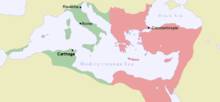유스티니아누스 페스트
유스티니아누스 페스트(Plague of Justinian)는 541년에서 542년까지 동로마 제국, 사산 제국, 그리고 지중해 연안 전역에 걸쳐 발생한 페스트 범유행이다.[1] (재유행은 750년까지 진행되었다.) 역사상 가장 끔찍한 페스트 범유행 중 하나였으며, 2천 5백만 ~ 5천만 명의 사람이 사망했다.[2][3] 유스티니아누스 자신도 이 병에 걸렸지만, 살아남았다고 한다.



발생 시기와 지역
편집유스티니아누스 1세가 동로마 제국의 황제로 있던 시기에 발생했기 때문에 이러한 이름이 붙여졌다. 수도 콘스탄티노플 뿐만 아니라, 지중해 전체의 항구 도시들과 사산 제국까지 괴롭힌 범유행 전염병이었다.[4][5] 콘스탄티노플이 항구도시이다 보니, 상선에 전염병에 감염된 벼룩을 달고 다니는 쥐가 항상 들끓었던 것이다.
사망자 수 추정치
편집일부 역사가들은 유스티니아누스 페스트가 역사상 가장 치명적인 전염병 중의 하나라고 생각하며, 나중에 2세기 후에 재발까지 한 것을 계산하면, 1억 2천만까지 사망에 이르렀다고 추정한다. 이 인구는 유럽 인구의 절반에 해당하는 수이다.[6][7][8] 페스트 범유행의 사회적, 문화적 영향은 14세기 유라시아를 황폐화시킨 흑사병의 영향과 비교되는 수준이다.[9] 하지만, 2019년도 새로운 연구 결과에 의하면, 유스티아누스 페스트의 사망자 수와 사회적 영향이 과장되었다고 한다.[10][11]
감염균
편집2013년에 연구원들은 유스티니아누스 페스트의 원인이 흑사병을 일으키는 박테리아와 동일하다고 발표하였다.[12][13] 흑사병이 훨씬 짧은 기간에 발생했으나, 유럽인의 1/3~1/2를 죽일만큼 강했다. 키르기스스탄, 카자흐스탄, 중국 국경의 톈산산맥에서 해당 박테리아의 균주가 발견되었다.[14][15]
전염병 주기
편집전염병은 8세기(약 750년까지)까지 주기적으로 돌아 왔다.[5]
각주
편집- ↑ “The Sixth-Century Plague”. 2017년 2월 20일에 원본 문서에서 보존된 문서. 2015년 3월 8일에 확인함.
- ↑ Rosen, William (2007), Justinian's Flea: Plague, Empire, and the Birth of Europe. Viking Adult; pg 3; ISBN 978-0-670-03855-8.
- ↑ Moorshead Magazines, Limited. "The Plague Of Justinian." History Magazine 11.1 (2009): 9–12. History Reference Center
- ↑ Floor, Willem M.,. 《Studies in the history of medicine in Iran》. Washington, DC. ISBN 978-1-933823-94-2.
- ↑ 가 나 B. A., History. “Before the Black Death, There Was the Sixth-Century Plague” (영어). 2020년 4월 12일에 확인함.
- ↑ “An Empire's Epidemic”. 2020년 4월 12일에 확인함.
- ↑ Rosen, William, 1955-2016. 《Justinian's flea : plague, empire, and the birth of Europe》. New York. ISBN 0-670-03855-5.
- ↑ “The Plague of Justinian”. 《History Magazine. 11 : 9–12.》. 2009.
- ↑ 《Interdisciplinary public health reasoning and epidemic modelling : the case of Black Death》. Berlin: Springer. 2005. ISBN 978-3-540-28165-8.
- ↑ Mordechai, Lee; Eisenberg, Merle; Newfield, Timothy P.; Izdebski, Adam; Kay, Janet E.; Poinar, Hendrik (12 17, 2019). “The Justinianic Plague: An inconsequential pandemic?”. 《Proceedings of the National Academy of Sciences of the United States of America》 116 (51): 25546–25554. doi:10.1073/pnas.1903797116. ISSN 1091-6490. PMC 6926030. PMID 31792176.
- ↑ Mordechai, Lee; Eisenberg, Merle (2019년 8월 1일). “Rejecting Catastrophe: The Case of the Justinianic Plague”. 《Past & Present》 (영어) 244 (1): 3–50. doi:10.1093/pastj/gtz009. ISSN 0031-2746.
- ↑ “Modern lab reaches across the ages to resolve plague DNA debate” (영어). 2020년 4월 12일에 확인함.
- ↑ News (2014년 1월 28일). “Plague DNA found in ancient teeth shows medieval Black Death, 1,500-year pandemic caused by same disease ; National Post” (캐나다 영어). 2020년 4월 12일에 확인함.
- ↑ Eroshenko, Galina A.; Nosov, Nikita Yu; Krasnov, Yaroslav M.; Oglodin, Yevgeny G.; Kukleva, Lyubov M.; Guseva, Natalia P.; Kuznetsov, Alexander A.; Abdikarimov, Sabyrzhan T.; Dzhaparova, Aigul K. (2017). “Yersinia pestis strains of ancient phylogenetic branch 0.ANT are widely spread in the high-mountain plague foci of Kyrgyzstan”. 《PloS One》 12 (10): e0187230. doi:10.1371/journal.pone.0187230. ISSN 1932-6203. PMC 5658180. PMID 29073248.
- ↑ Damgaard, Peter de Barros; Marchi, Nina; Rasmussen, Simon; Peyrot, Michaël; Renaud, Gabriel; Korneliussen, Thorfinn; Moreno-Mayar, J. Víctor; Pedersen, Mikkel Winther; Goldberg, Amy (05 2018). “137 ancient human genomes from across the Eurasian steppes”. 《Nature》 557 (7705): 369–374. doi:10.1038/s41586-018-0094-2. ISSN 1476-4687. PMID 29743675.